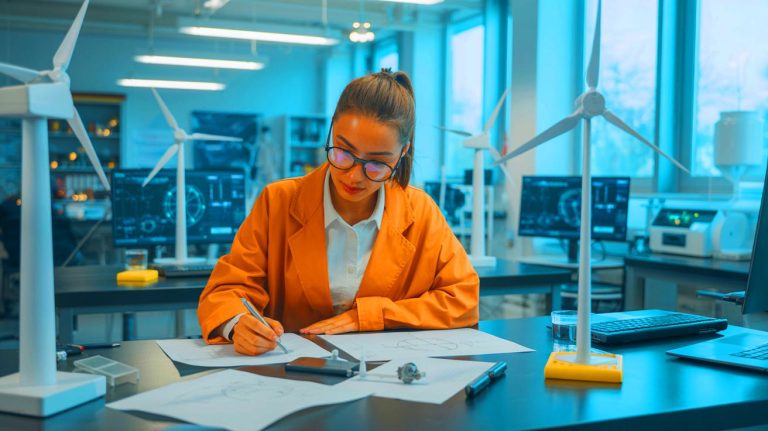| IN A NUTSHELL |
|
In the realm of scientific breakthroughs, few stories are as compelling as that of a Penn State student who has cracked an aerodynamic puzzle over a century old. The implications of this discovery stretch far beyond academic circles, promising to revolutionize the way wind power is harnessed and utilized. By revisiting and refining an equation that had long been relegated to the annals of history, this young scholar has opened new doors for sustainable energy solutions, potentially transforming the landscape of renewable energy across the globe.
Reworking Glauert’s Forgotten Aerodynamic Puzzle
Over a century ago, the esteemed British aerodynamicist Hermann Glauert introduced a pivotal equation designed to estimate the maximum power coefficient of wind turbines. This coefficient is crucial as it gauges how effectively turbines convert wind into electrical energy. However, Glauert’s original formulation was incomplete, missing essential physical forces such as downwind thrust and root bending moments. These omissions have long posed challenges for engineers striving to optimize turbine design.
Enter Divya Tyagi, a graduate student at Penn State, who has breathed new life into this aged equation. By expanding and refining Glauert’s work, Tyagi has created a modern framework that accurately accounts for real-world turbine conditions. Her innovative solution not only enhances energy output but also addresses the structural stress on turbine blades, making it a crucial tool for engineers worldwide.
A Thesis That Became a Scientific Contribution
Tyagi’s journey began during her undergraduate years at Schreyer Honors College, where she embarked on this ambitious project under the guidance of Dr. Sven Schmitz. Her work evolved into a thesis that has since been recognized as a significant contribution to the field of wind energy science. Schmitz, who had previously deemed the original Glauert model as overly complex, was impressed by Tyagi’s determination and innovative approach.
Employing the calculus of variations and constrained optimization techniques, Tyagi reimagined the problem, making it more accessible for practical engineering applications. Her solution stands as a testament to the power of perseverance and intellectual curiosity, transforming what was once a daunting academic exercise into a groundbreaking contribution to sustainable technology.
Quantifying the Real-World Impact
The potential impact of Tyagi’s work is profound. Even a modest 1% increase in the power coefficient can dramatically enhance the energy output of a wind turbine, enough to power entire neighborhoods. This improvement, when applied across multiple turbines, could significantly boost the efficiency of renewable energy sources, leading to cost reductions and increased feasibility.
Moreover, Tyagi’s model addresses other critical coefficients, such as those for total force and bending loads, areas that Glauert’s original equation failed to cover. Her contributions offer a more comprehensive understanding of turbine dynamics, paving the way for innovations that could reshape the future of energy production.
These decommissioned wind turbine blades transformed into asphalt are paving the roads of tomorrow
Academic Recognition and Expanding Research
In recognition of her outstanding work, Tyagi received the prestigious Anthony E. Wolk Award for the best senior thesis in aerospace engineering at Penn State. Her refined equation is poised to become a staple in aerospace curricula and research labs, influencing future generations of engineers and researchers.
Currently, Tyagi is pursuing her master’s degree, focusing on computational fluid dynamics (CFD) to explore airflow around helicopter rotors. Supported by the U.S. Navy, her research aims to enhance pilot safety and landing precision. This new venture underscores her dedication to advancing our understanding of complex flow interactions, bridging her foundational work in wind energy with cutting-edge aerospace applications.
Perseverance Behind the Equations
Tyagi’s journey is a testament to the power of perseverance. She devoted 10 to 15 hours a week to untangling dense mathematical challenges and refining her thesis. Despite the arduous process, her determination paid off, culminating in a solution that is both elegant and impactful.
Reflecting on her journey, Tyagi expressed immense pride in her accomplishments. Her advisor, Schmitz, lauded her persistence and clarity, acknowledging that her work not only solves a complex problem but also sets a new standard in the field. As we look to the future of sustainable energy, one question remains: How will Tyagi’s groundbreaking work inspire the next wave of innovations in renewable energy?
Did you like it? 4.5/5 (20)






Wow, this is truly amazing! Congrats to Divya for solving a century-old puzzle! 🎉
How exactly does this new equation improve wind turbine efficiency? 🤔
This is impressive, but how scalable is this solution in the real world?
Can someone explain what “root bending moments” are? I’m lost! 😅
If this is true, why did it take so long to solve? What were the main challenges?
Great job, Divya! Hope this leads to more breakthroughs in renewable energy. 🌍